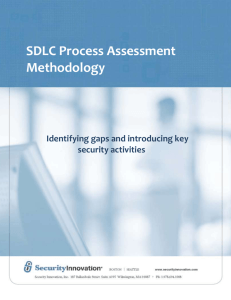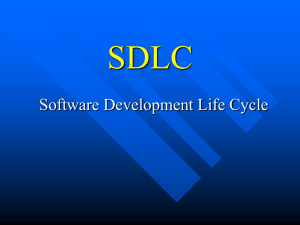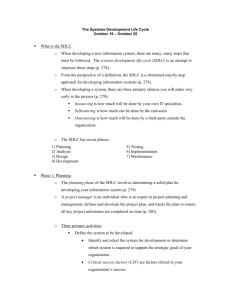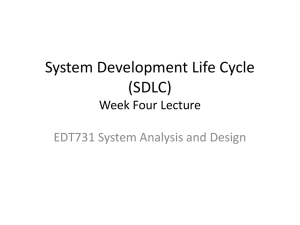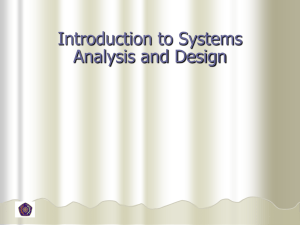Case Study:
advertisement
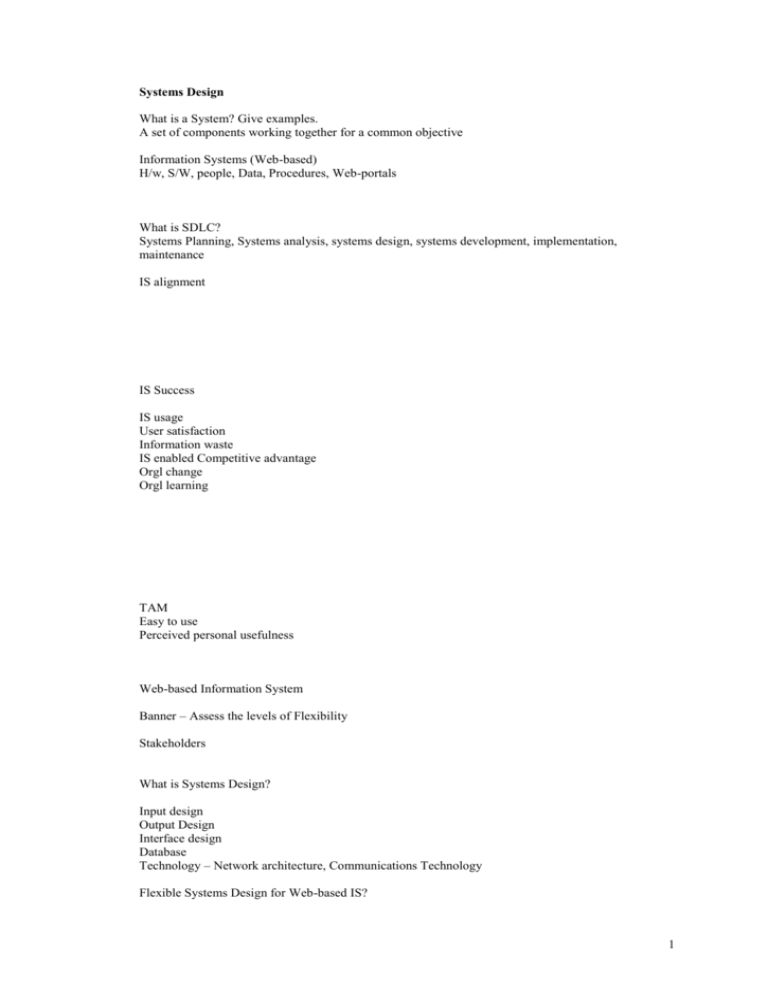
Systems Design What is a System? Give examples. A set of components working together for a common objective Information Systems (Web-based) H/w, S/W, people, Data, Procedures, Web-portals What is SDLC? Systems Planning, Systems analysis, systems design, systems development, implementation, maintenance IS alignment IS Success IS usage User satisfaction Information waste IS enabled Competitive advantage Orgl change Orgl learning TAM Easy to use Perceived personal usefulness Web-based Information System Banner – Assess the levels of Flexibility Stakeholders What is Systems Design? Input design Output Design Interface design Database Technology – Network architecture, Communications Technology Flexible Systems Design for Web-based IS? 1 Examples: Banner, Amazon.com, Dell.com – Identify the systems design elements Flexible Systems Design for Web based Information Systems (Research) BOM changes affect MRP In the Banner system, what are the changes that could occur? How do we respond to these changes? Interviews them Users – Students, Registrar (Shannon), Dean, etc. Designers / Planners – Gary Administration Explore the dimensions – Extent, Options, cost, easy, Range, etc. Gain more insight by getting more examples. Application architecture Design Interface design (User/ System) Database Network Prototype Systems controls 2 Case Study: What information systems we are talking about… Stake holders for this system Involvement of stakeholders in SDLC Systems Design activities Design decisions What are the alternatives for H/W, O/S, Database, PL decisions Outputs of each Design phase Project Management activities in SDLC/ Systems design Set a Time line for this Systems design project What are the detailed design tasks 3 4 Case Study: Skills required for Systems Design and Development People skill (25%) - Listening, understanding others, understanding between two lines, conflict resolution, handling the communications gaps, reporting, walk through, reviews. Communication Skills (20%) – Oral / Written communication Documentation skills (30%): Knowledge capturing, diagrams, charts (structure charts, Gantt charts, Business knowledge (business processes, business management knowledge) Technical skill (25%) - Database design, programming, web design etc. What information systems we are talking about… 1. Design of production scheduling and control system (ERP?) 2. Web-based production scheduling and control system 3. Production scheduling and control system Stake holders for this system 1. Users, oversight committee, Production Manager, Chief Analyst 2. Users, employees, oversight committee, Carla 3. Users, oversight committee, Project Manager (Carla) Involvement of stakeholders in SDLC 1. Suppliers, Customers, Distributors 2. Financial involvement of stakeholders 3. Users & oversight committee – Systems planning & analysis; Project managers – all phases – involvement through out SDLC. Systems Design activities 1. Select DBMS, Programming Languages, Operating systems, user interface, network design, Architectural design, interface design, network design, database design 2. Hardware & operating systems, web support services, database design, application software design, user interface design 3. Developing database, choosing system software to support web services, determining what changes will be needed to company network Design decisions 1. DBMS selection, application software selection, web support services selection, Hardware, OS, network changes. 5 2. Selection of Hardware, OS, DBMS, PL. 3. MySQL, Windows, Linux, JavaScript, PHP What are the alternatives for H/W, O/S, Database, PL decisions 1. H/W- Servers/ terminals, Hard rive types (speed, size, processor, RAM etc.); OS –Windows, UNIX, Linux; DBMS_ Exiting/ new one; PL - COM+, CORBA, SOAP 2. H/W – generic, IBM, Dell, HP, Sun, Apple; O/S- Windows, Linux, OSX, Sun; Database- Extend existing or new database- Oracle/Access/MySQL; P/L – COM+, CORBA, SOAP C++, JavaScript, PHP, SQL, HTML, XML. 3. MySQL, Windows, Linux, JavaScript, PHP Outputs of each Design phase 1. Database schema, Structure chart, screen layout, deployment diagram, application design, DB schema, ERD, Network diagram 2. Assessment reports, recommendations for each design activity. 3. Hardware specification documents, ERD, screen layouts Project Management activities in SDLC/ Systems design 1. Resource allocation, organizing meetings, key players meeting, time lines, personal assignments; plans, timelines, detailed design tasks, personnel assignment, facilitate meetings, review results, performance reviews, 2. Prepare presentations; get approval from oversight committee, allocating resources. 3. Setting deadlines, feasibility studies, overseeing Set a Time line for this Systems design project My comments Fairchild Pharmaceuticals: Finalizing Architectural Design for a Production System: This case describes the transition from analysis (detailed knowledge of what the user wants and needs) to design (precise blueprint of a system that will satisfy those wants and needs). Design decisions are constrained by available time, budget, existing systems, skills, and infrastructure. Focus of the case: Architectural design of infrastructure, development tools, Detailed design. Major decisions to be made: Hardware and operating systems, data storage and data access, and development languages and tools. Options to be made for: Web support services, database design, application software design, and user interface design. 6 What information systems we are talking about… Web-based production scheduling and control system Stake holders for this system Users, oversight committee, Production Manager, Chief Analyst, Production & operational employees, Project Manager, top management, consultants, graphic designers, database designers, user interface designers, system interface designers, application developers, network specialists etc. Involvement of stakeholders in SDLC SDLC phases Users Suppliers, (Production Customers, employees) Distributors Top management Technical people Planning Analysis Design Implementation High High Medium Low High Medium/Low Low Low/Medium Low/Nil Medium/High High High Medium Medium/High Medium Low Systems Design activities Design and integrate the network New Network/ Existing Network Design the application architecture Specify in details how all system activities will actually be carried out Done in systems analysis in great detail as logical models, without indicating what specific technology Models created include physical data flow diagrams, structure charts, interaction diagrams, and other physical models Design the user interface Defines how the user will interact with the system Graphical user interface with windows, dialog boxes, and mouse interaction. Increasingly, it can include sound, video, and voice commands. Design the system interface (BOM/ MRP) One system provides information that is later used by another system The component that enables systems to share information Design and integrate the database Conceptual, logical, and physical model Relational database consisting of dozens, hundreds, thousands of tables. Prototype design 7 Create and evaluate prototypes Often associated with interface design Used to confirm design choices about the database, network architecture, controls, or even programming environments Design and integrate the system controls Adequate safeguards to protect data/information/ H/w, S/w assets Limit access to the system to authorized users System interface controls ensure that other systems cause no harm Application controls for recording transactions Database controls - data protection from unauthorized access, accidental loss Network controls - ensure that communication through networks is protected. The outputs of Systems Design Process Application architecture (Process Design) Functionalities/ Business Processes DFD, FDD, Event table, use case etc. Structured Programming Sequential, Conditional, Iterative – 3 & 4GL. Network Design Network design document Locations of offices, Servers, LAN/WAN Network capacity (Fig 9-14) Nodes and location diagrams (Fig 9-8) Database Design Conceptual Design Logical Design Physical Design User Interface Design Input forms design Output forms design System Interface Design forms (BOM/ MRP) Design Prototype 4GL (Access and Frontpage) Design and Integrate Systems Control User interface- Allow authorized users System Interface- No harms by other systems ((BOM/ MRP) Application architecture – Transaction rules Database architecture- Protect unauthorized access, back-up, recovery 8 Network design- Firewalls Project Management activities in SDLC/ Systems design Knowledge Planning Analysis Design Areas Scope Objectives Detailed Control scope management Business needs requirements Monitor request Major functions Verify reqts. log Solidify scope Evaluate change Plan request implementation approach Implementation Control scope Monitor request log Evaluate change request Time management (in time) Build WBS Build Schedule Milestones (Gates) Adjust/ optimize schedule Monitor progress Adjust/ optimize schedule Monitor progress Adjust/ optimize schedule Monitor progress Cost management Cost / benefits analysis Budget (cash flow) Monitor ongoing costs Update cost/benefit Monitor ongoing costs Review budget/cash flow Monitor ongoing costs Review budget/cash flow Quality management Quality metrics System success metrics Control Quality with procedures and reviews Control Quality with procedures and reviews Control and monitor testing Error log Human Resources Management Project manager Staffing plan Recruit and staff Organize teams Team building Team training Identify/add resources Performance reviews Provide training Conduct performance reviews. Communication Identify management stakeholders Communication plan/ mechanisms Risk management Feasibility reports. Alternative plans Status reviews Status reporting Monitor internal communications Status reviews Status reviews Status reporting Status reporting Monitor internal Monitor internal communications communications Reassess risks and monitor Reassess risks and monitor Reassess risks and monitor PRs, bids, Reassess risks Reassess risks 9 Buy options Procurement management vendor selection, contracts and monitor and monitor Outstanding issue control table Issue Title Date identified/ target date Person responsible User contact Comments Partial shipments Jim Jason Ship partials or wait for full shipment? Return and commissions Jim Bill Are commissions recouped on returns? Extra commissions Mary Bill How to handle commissions on special promotions? Status (Done, WIP, Not feasible) D NF WIP Project Schedule (Gantt Chart) Activities/ Gates /Milestones Jan Feb Mar Apr May Jun Jul Aug Sep Oct Nov Dec Planning Analysis Design Coding Test case development Data Conversion 10 Sequential and Parallel activities (Database design & Network design, status meetings, teleconferencing etc.) Team coordination Network design team Database design team Application architecture design team User interface design team System interface design team Systems controls design team Prototype design team Team interaction among and between the teams (examples?) Collaborative diagrams for group interactions Common activities for all teams: Status reviews, walk throughs, network configuration, distributed processing, database design, communication capabilities etc. Uncommon activities (Team specific) – Response time for a module, I/O for a module, System interface issues etc. Project team size grows as the system development progresses thru’ SDLC. CASE data repository (Fig 9-6) Knowledge documents - Word, Excel, Visio dgms Dynamically updated Retrieval and referencing Track open items Status walk throughs Open item control log 11 12



